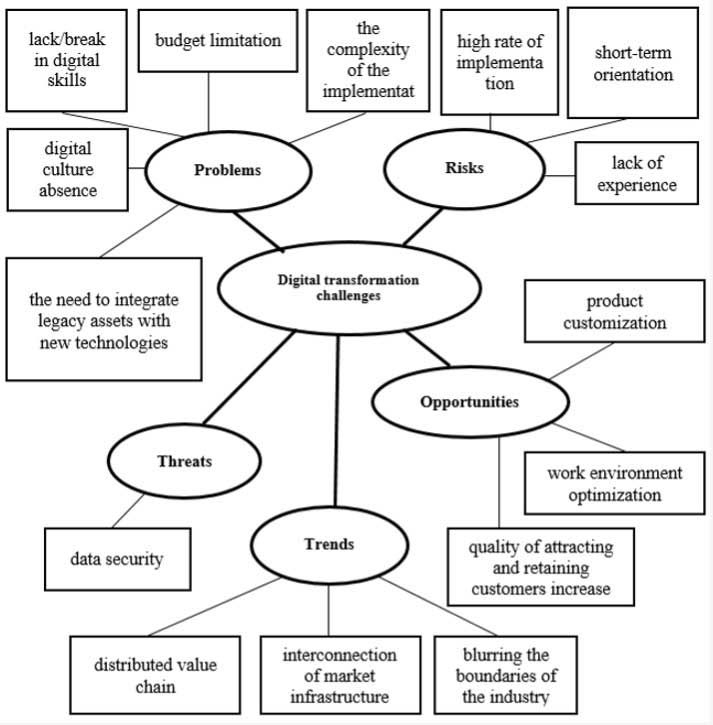At the same time, changes in conditions common for different companies (for example, the structure of the market environment, economic sanctions, customs restrictions, etc.) affect their position in different ways, moreover, situations are possible when the same change in conditions for some market participants it means improvement, due to their competitive advantages, and for others - decline. For some companies, the part of the challenges are threats, and for others, opportunities. That is, the interests of different companies in relation to these challenges do not necessarily coincide, and may even be strictly antagonistic, which significantly limits or even excludes the possibilities of cooperation to overcome them.
The digital transformation (DT) challenge map contains generalized thematic constructs (problems, risks, threats, trends and opportunities),

Problems
- The need to integrate legacy assets with new technologiesToday, technology integration is ensured by the flexibility of IT, new corporate platforms, and a strong and scalable operating system, which is part of the digital infrastructure. Here raises perhaps the biggest technology challenge for companies moving towards digitalization: how to integrate existing “analog” assets with digital tools. Many companies made significant investments in services that today are not able to create new value and opportunities for business. But giving them up is too expensive. Solving the problem of effectively integrating legacy software within the DT process can repackage the value of 'analog legacy' into vital elements of a digitized company.
- Digital culture absence
Digital transformation is a technology-driven challenge that requires deep cultural change within a company. Two premises lead to this:
** First, in the digital era, data shall be seen as a valuable resource and a means of achieving the goals of digitalization. In this context, companies need to 'expand' their corporate culture with significant aspects of digital culture. Compared to corporate culture, digital culture values IT as a key element of strategic and tactical decisions and clearly understands the financial and transformative potential of digital technology.
** Secondly, DT can cause cultural conflict between young and relatively inexperienced employees of the digital generation and older, but more experienced employees working before the transition to digital.
- Lack/break in digital skills
Another challenge in the context of digitalization challenges is the management of two- way capabilities, in terms of analog and digital skills. Companies have to incorporate 'old' and 'new' skills into their pool of capabilities. It shall be done in such a way that they do not interfere, but complement each other. In the digital world also important networking skills, platforms, and ecosystems. Depending on contextual factors such as industry or business model, companies must learn to take advantage of network effects in terms of additional opportunities, and learn to transform into an ecosystem rather than continue to manage value chains.
- Budget limitation
When it comes to DT, budget limits are troubling companies around the world. According to a World Economic Forum survey, the cost of digital technologies is the most sharp barrier to their implementation (45% of respondents indicated this). Sometimes budgets are made at least six months or a year in advance, creating a deficit for promising digital investments. Often, the budgets of companies are consolidated by management, and changing business processes to create new value in the digital realities is associated with limitations and fluctuations in terms of making changes to the budget.
- The complexity of the implementation of digital technologies
Digital technologies are constantly generating new tools. And the business keeping at a competitive level requires the constant learning of these new tools. Continuous and complex nature is one of the important problems of DT. Several digital systems/platforms in a company can be incorporated into each other, which is confusing, repressing, destroying targets.
Risks
- Short term orientationWhen companies enter DT, they have to overcome three risks that affect the planning and cost of transformation (Yeo et al., 2018). The first is blindly beginning on digital transformation, the second is the introduction of unnecessary technologies, and the third is the erroneous conclusion that this is a one-time process. And here one of the biggest challenges is to ensure that planning for digital transformation goes beyond planning for the first three to five months. Otherwise, implementation becomes a mere project task that threatens to undermine years of work, millions invested, and organizational breakdown suffered.
- Lack of experience
Research showed that only 23% of companies admit they have a strategy of corporate digital transformation. An enormous 77% of companies are with no overall corporate strategy, focus, or implementation plan. At the same time, 38% of companies surveyed have a separate business segment or product line that determines the digital transformation of their company.
- High rate of implementation
During the DT period, the rate of technological change accelerates disproportionately, and new digital opportunities emerge every year. The capabilities of end-to-end technologies such as the Internet of Things (IoT), Big Data, cloud computing and mobile technologies are significantly accelerating the overall pace of change. The answer to this should be a faster cycle of strategy development and implementation. A fast and ever-changing digital environment is forcing managers to make decisions and implement strategies much faster than previously required.
Opportunities
- Product customizationWith digitalization, manufacturers can take customer feedback to the next level. It is possible due to hundreds of sensors aggregating data in real time. This dataset provides invaluable information to those responsible for product / service development. Product customization is a trend that will become more and more important and important for a wider range of companies. Digital technology enable to move to the small batch and mixed production, opening the door to individual product customization. The benefits of this are significant, including increasing revenues, expanding brand reach, and building better customer relationships.
- Work environment optimization
Business digitalization is also changes the day-to-day work environment in companies in terms of work structure, job roles and workplace requirements. Digital collaboration enables flexible and networked teams to be built across multiple locations across a company's geographic map. In this context, traditional hierarchical structures disappear and new opportunities appear outside the company, such as the integration of external freelancers. In addition, the introduction of the digital workplace is becoming inevitable.
- Quality of attracting and retaining customers increase
Customers are behaving differently than before in the new digital marketplace, and traditional marketing methods are becoming ineffective. Today, customers have many ways to easily gather information about products and services well in advance of the actual purchase. In this sense, digital technologies are also transforming the activities of customer interaction strategies. Reaching customers in a digital environment requires digital omnichannel marketing, including social media, mobile apps and augmented reality. In addition, digital technologies are more reducing information asymmetry between buyers and sellers: the availability of information and its ubiquity are fundamentally changing the accepted rules of relations between them. Diversified digital platforms and networks have virtually displaced intermediaries from the analog world.
Threats
DT's main threats are focused on cybersecurity. And there are several 'benchmarks' here: first, cybernetics (the growing number of devices combined with more sophisticated threat sources means that the risk of a cyberattack is higher than ever); secondly, the use of cloud services (the risks associated with moving or deploying systems to the cloud architecture continue to grow); third, data privacy (controls and regulation of personal information are expanding and, if not managed properly, it can undermine the company's trust, reputation and profits). However, security shall be seen not only as a challenge, but also as evidence of the need to accelerate DT initiatives.Trends
- Distributed value creationA review of the literature shows that during the DT, the value chain became much more distributed. Two major changes can be observed here: firstly, digital technologies offer customers the opportunity to co-create products with a manufacturer, for example, through digital platforms, and secondly, value at the inter-company level is increasingly co- created and reflected in a series of partnerships in value creation network. Hence, it can be argued that network effects are a key differentiator and driving force behind the creation and capture of value in the digital world. Thus, the accent in value creation is shifting from the value chain to the value network.
- Blurring the boundaries of the industry
Digital transformation is redefining, blurring and even erasing existing industry boundaries, which can lead, on the one hand, to cross-industry competition (the logic of the dominant industry no longer works, and even new small companies can become serious competitors, and on the other, to digital convergence (convergence of various network platforms during realization of essentially similar types of services). On the supply side, digital convergence is characterized by the use of the same knowledge base by different industries; on the demand side, it erases the boundaries of markets.
- Interconnection of market infrastructure
With the advent of digital platforms, networks and ecosystems, market infrastructure becomes more interconnected in a broader sense, there is a transition from control or participation in a linear value chain to work in an ecosystem or network. As different types of innovative networks emerge, with a different cognitive and social translation of knowledge, new digital infrastructure properties shall be required to support each such network. Thus, digital technologies increase the knowledge heterogeneity of innovation networks. However, it should be noted that the free flow of digital products accelerates the destruction of property rights and increases the risk of imitation.







